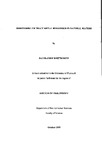MONITORING OF TRACE METAL BEHAVIOUR IN NATURAL WATERS
| dc.contributor.author | WHTTWORTH, DAVID JOHN | |
| dc.contributor.other | School of Geography, Earth and Environmental Sciences | en_US |
| dc.date.accessioned | 2013-09-16T09:40:30Z | |
| dc.date.available | 2013-09-16T09:40:30Z | |
| dc.date.issued | 1999 | |
| dc.identifier | NOT AVAILABLE | en_US |
| dc.identifier.uri | http://hdl.handle.net/10026.1/1732 | |
| dc.description.abstract |
An automated voltammetric dissolved trace metal monitor was developed and validated for in situ analysis of estuarine waters. The system was successfully applied to the determination of Ni concentrations during two studies in the Tamar Estuary. The automated system used Adsorptive Cathodic Stripping Voltammetry (AdCSV) for trace metal analysis with a continuous flow sampling procedure and an on line LTV digestion system to ensure complete breakdown of interfering and metal complexing organic ligands. Its application to the measurement of total dissolved Ni in the Tamar Estuary showed a high measuring frequency of up to 6 fully calibrated samples per hour and trace metal concentrations ranged between Ni --10 nM to -50 nM with a salinity gradient of between -0 to -25. A procedure was developed to evaluate suspended particulate material (SPM) trace metal extraction efficiencies of using EDTA extraction solutions followed by analysis of metals using Inductively Coupled Plasma Mass Spectrometry. The use of EDTA allowed the determination of the easily exchangeable particulate metal fraction using well defined constraints with respect to the competition between EDTA and the particles. Optimum particle extraction time was 72 hours, using 0.05 M EDTA concentration and extractant : particle ratio of 200:1, The extraction procedure was applied to the study of particulate Zn, Ni, Cu, Mn and Mg composition of SPM collected from the Scheldt Estuary. In addition, seasonal investigation of dissolved chemical speciation of Cu, Co, Ni and Zn in the Tamar estuary using AdCSV was undertaken. The results showed contrasting behaviour for these metals with a high seasonal variability of Zn and Co and a low seasonal variability for Cu and Ni. The low concentration of Zn and Co during summer months suggested that low river flow rates, low rainfall caused minimal sediment disturbance thereby reducing the contribution of Co and Zn enrich pore waters to the estuary. Furthermore, it was suggested that uptake of Zn and Cu by phytoplankton could have contributed to the lower concentrations of these elements during the summer survey. The electrochemically non labile fraction of dissolved Cu, Zn, Ni and Co exhibited highest values at high salinities and indicates the importance of organic complexation of these metals in the lower estuary. Furthermore, during the spring surveys elevated fractions of organically complexed Cu, Zn, and Ni were observed and it was suggested that seasonally enhanced levels of primary productivity could have lead to the complexation of these elements by algal exudates and break down products. 0.05 M EDTA extraction protocol was applied to the study of dissolved and particulate Zn, Cu, Co and Ni in the Scheldt estuary. Dissolved Co and Ni exhibited elevated concentrations in the upper estuary, which were related to anthropogenic discharges into the estuary. Its was possible to identify a relationship between particulate organic carbon and particulate Zn, Cu and Ni, which suggested that complexation of these elements by organic particulate material was an important factor in their dissolved/particulate partitioning. Results of dissolved Cu natural complexing ligand titration experiments showed similar behaviour for CUL and K^^^ for the Tamar and Scheldt estuaries with high values at low salinity decreasing to low values at high salinity. The Scheldt generally exhibited higher values for K^^,^ and CUL concentrations ( / ^CU^ -15.7; CUL -200 Cu neq 1"*; S = 1) than the Tamar estuary (/C^^^ 14.0; CUL -170 Cu neq 1"'; S = 0). It was suggested that anthropogenic inputs of nutrients in the Scheldt lead to enhanced levels of phytoplankton activity and complexation of Cu by algal exudates and break down products compared with the Tamar. Total dissolved Ni and Co was undertaken on samples collected from the Atlantic Ocean using detection by AdCSV. The results indicated that Ni and Co exhibited contrasting behaviour in the oceanic waters compared with estuarine waters. The distribution of Co showed low concentrations (mean Co -40 pM) in the Atlantic Ocean and elevated concentration associated with aeolian particulate inputs off the Northwest coast of Africa. In contrast, Ni was relatively homogeneously distributed over large parts of the Atlantic (2.4 ± 0.7 nM). However, both Ni and Co exhibited conservative behaviour during mixing between the Brazilian Current with the Ni and Co enriched Falklands Current indicating the importance of physical water transport on trace metal distribution in oceanic systems. | en_US |
| dc.language.iso | en | en_US |
| dc.publisher | University of Plymouth | en_US |
| dc.title | MONITORING OF TRACE METAL BEHAVIOUR IN NATURAL WATERS | en_US |
| dc.type | Thesis | en_US |
| plymouth.version | Full version | en_US |
| dc.identifier.doi | http://dx.doi.org/10.24382/1379 | |
| dc.identifier.doi | http://dx.doi.org/10.24382/1379 |
Files in this item
This item appears in the following Collection(s)
-
01 Research Theses Main Collection
Research Theses Main


